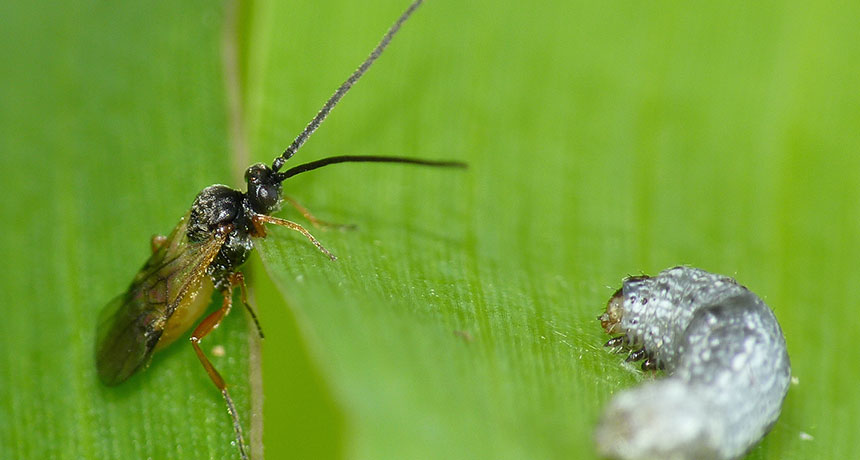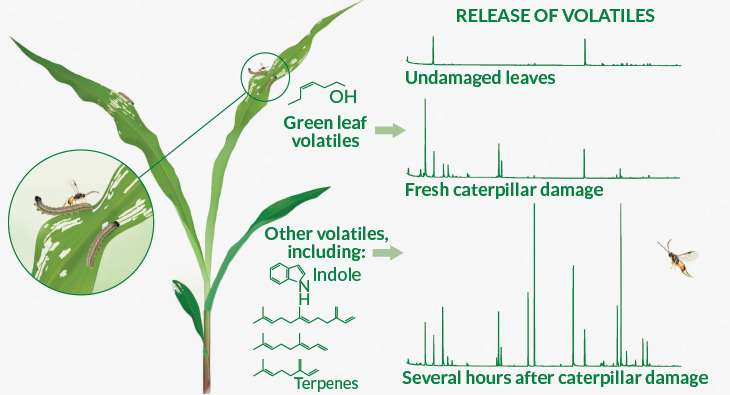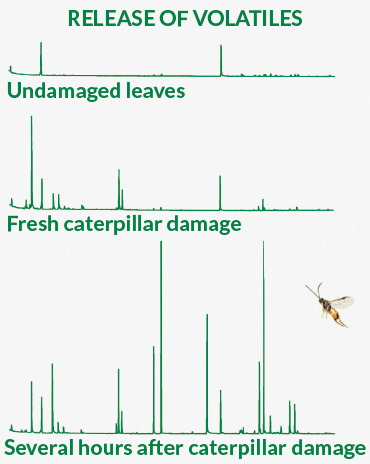
DESPERATE BATTLE Eating disgusting leaves may save an Egyptian cotton leafworm (right) from the zombie-making Microplitis rufiventris wasp that a corn plant lured in with odors.
Matthias Held/University of Neuchâtel
Here’s the story of a caterpillar that foils gruesome violence orchestrated by corn.
No, that’s not backward. Plants often look helpless to a human, but they fight with smells and other invisible chemistry. A growing body of evidence, for example, shows that plants under attack can waft out scents that attract help, such as tiny wasps that deal a lingering death to leaf-chewing caterpillars.
A dream for future farming is to boost such crop powers. Yet a tale, published May 16 in Science Advances, of how Spodoptera littoralis caterpillars can escape a trap set for them by maize plants shows how complex a task that could be.
These attackers are “greenish, brownish, ugly caterpillars,” says Ted Turlings of the University of Neuchâtel in Switzerland, who makes no secret of where his allegiance lies. The caterpillars damage maize, cotton and a variety of other crops in the Middle East, Africa and elsewhere. But maize fights back, of course. As the caterpillars crunch into a leaf, substances in their spit trigger a burst of furious plant chemistry, which causes the release of certain scents.
The first wave of odors from damaged plants, the cut-grass smell, comes just from ripped tissues spilling their innards. Then within hours, maize sends out new scents that can advertise the kind of pests attacking it. “You can actually smell it yourself,” Turlings says. Or at least his trained nose can.
These telltale plant substances help female Microplitis rufiventris wasps track down a suitable species of fresh caterpillar flesh. The females cruise for caterpillars as sites for injecting an egg. “Out of that egg comes a little larva, and it starts eating the insides of the caterpillar — not a very pleasant thing,” Turlings says. Caterpillars continue feeding for several days but then just passively stay alive longer as a source of fresh baby food.
What Turlings and his colleagues have found, however, is that what the caterpillar eats makes a difference. Wasps were more interested in caterpillars grazing on maize that researchers genetically engineered not to produce a plant defense compound called indole. In contrast, wasps weren’t very likely to inject eggs if this caterpillar species had been feeding on normal maize leaves.
Smell the leaves


Undamaged maize leaves don’t give off much in the way of smells (top graph, each peak represents an airborne compound). When caterpillars first bite into a maize leaf, though, a wave of leafy green volatiles rise (middle graph). In a matter of hours, the leaf synthesizes other volatiles, including a compound called indole, that together offer more specific clues to the kind of attacker (bottom graph). These releases lure such caterpillar enemies as a female parasitoid wasp.
Indole’s “mothball-like odor [is] terrible in high dosages,” Turlings says. Caterpillars didn’t like it much either — except when female wasps were zinging around them. Then the caterpillars fed willingly enough, a test showed. “It’s almost like self-medicating,” he says.
There’s a cost to the caterpillars’ choice to consume indole-rich foliage. “They grow fatter but not healthier,” Turlings says. More die prematurely. On the plus side, wasp eggs don’t flourish as well inside these caterpillars if a wasp does try to use them as zombified baby food. The odor of pure indole could attract the wasps, but caterpillars bulked up on indole-rich leaves did not, the researchers found in lab tests. This caterpillar’s feeding evolution had found a loophole in maize’s defense strategy.
Just about every plant tested so far synthesizes special compounds that can lure in some kinds of natural enemies of pests, Turlings says. Yet he’d never run across a caterpillar with this bad-food strategy of avoiding the wasps.
Caterpillars evolving a work-around defense against a widespread plant defense don’t shock chemical ecologist James Tumlinson of Penn State University. In these ornate biological systems of deceit and manipulation, “pretty much anything you can think of is possible,” he says. “Once we get over our surprise, it nearly always makes evolutionary sense.”






